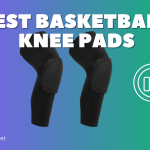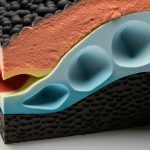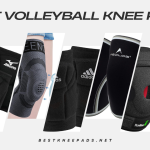If you’re a volleyball player, you know how important it is to protect your knees during games. Volleyball knee pads are an essential sports accessory for players of all levels, providing the necessary cushioning and support to prevent injuries and keep you playing at your best.
But have you ever wondered what these knee pads are made out of? In this section, we’ll take a closer look at the materials used to make volleyball knee pads, giving you a better understanding of what goes into this crucial piece of equipment.
Key Takeaways:
- Volleyball knee pads are essential for protecting your knees during games.
- Understanding the materials used in knee pads can help you make informed decisions when selecting the right pair for your needs.
- Common materials used in volleyball knee pads include neoprene and polyester.
- Foam padding and protective coatings/reinforcements are also critical components of knee pads.
- Choosing the right knee pads can enhance your performance and prevent injuries, making them a necessary investment for any volleyball player.
Importance of Volleyball Knee Pads
As a volleyball player, your knees are put under a lot of strain during games. Constant jumping, diving, and sliding can make your knees vulnerable to injury. That’s why knee protection is crucial, and volleyball knee pads are designed to provide just that.
Not only do volleyball knee pads offer vital knee protection, but they also improve overall performance. When you know your knees are protected, you can focus more on your game and play with confidence. Without knee pads, you may hesitate to make certain moves or avoid diving for the ball, ultimately limiting your potential as a player.
Moreover, knee injuries can be frustrating and time-consuming to recover from, meaning you miss essential training and game time. Therefore, maintaining knee protection through volleyball knee pads is essential to ensure longevity in the sport and keep you on the court.
Overall, the importance of knee protection for a volleyball player cannot be overstated. By investing in high-quality knee pads, you can reduce the risk of knee injuries, boost your confidence, and improve your overall performance on the court.
Common Materials Used in Volleyball Knee Pads
Several materials are commonly used to make volleyball knee pads. Understanding the properties and advantages of each material can help you choose the right knee pads for your needs and preferences.
Tip: When selecting knee pads, consider the surface you’ll be playing on, your level of play, and the intensity of the game. These factors can impact your choice of materials.
The most common materials used in volleyball knee pads include nylon, spandex, polyester, and neoprene. Nylon and spandex are known for their elasticity, giving a snug and comfortable fit. They are also durable and lightweight, making them a popular choice for volleyball players. Polyester is also a favored material for knee pads because of its moisture-wicking properties, making it ideal for absorbing sweat during intense games.
Focusing on Neoprene
Neoprene is a synthetic rubber material that is also commonly used in making knee pads. It is known for its flexibility, durability, and excellent shock absorption, making it ideal for volleyball players who need to make quick and sudden movements. Neoprene knee pads are also able to withstand wear and tear, ensuring long-lasting use.
Additionally, neoprene is lightweight, allowing for unrestricted movement and a comfortable fit. It also has a soft and smooth texture, preventing abrasions and skin irritation.
However, neoprene knee pads may not be suitable for players who sweat heavily during games. The material can trap heat and moisture, causing discomfort and irritation.
Ultimately, the choice of material for knee pads will depend on your preferences and needs. Consider the advantages of each material and choose the one that best matches your playing style and comfort level.
Neoprene Knee Pads
If you’re looking for knee pads that offer excellent shock absorption, flexibility, and durability, neoprene knee pads are an ideal choice. Neoprene is a synthetic rubber material that provides cushioning and support, making them perfect for the fast-paced and intense movements required in volleyball.
Due to the unique properties of neoprene, it has become a popular choice for athletes across various sports, including volleyball. Neoprene knee pads are designed to fit snugly around the knee, providing maximum protection and comfort during play.
“Neoprene knee pads are ideal for volleyball players who want to reduce the risk of knee injuries without compromising on performance.”
One of the significant benefits of neoprene knee pads is their excellent shock absorption capabilities. The material can absorb the impact of jumping, diving, and sliding, reducing the risk of injuries while still maintaining flexibility and range of motion.
Another advantage of neoprene knee pads is their durability. They can withstand the wear and tear of regular use and maintain their shape and size over time. Additionally, neoprene knee pads are water-resistant, which is particularly helpful in sweaty volleyball games or if you play outdoors in wet conditions.
Overall, neoprene knee pads are an excellent investment for volleyball players who want a durable, flexible, and comfortable knee pad that provides excellent protection against injury. With neoprene knee pads, you can play with confidence, knowing that your knees are well-protected.
Polyester Knee Pads: The Perfect Solution for Moisture-Wicking
If you’re a volleyball player, you understand the importance of knee pads in keeping you protected during the game. However, not all knee pads are created equal, and choosing the right material is just as important as selecting the right fit. One of the most popular materials for knee pads is polyester, and for good reason.
Polyester knee pads offer excellent moisture-wicking properties, making them ideal for intense games where sweat can be an issue. Unlike other materials, polyester wicks away moisture from your skin, keeping you dry and comfortable during the game. This is especially beneficial during long matches where you’ll need to stay focused and alert.
“Polyester knee pads offer excellent moisture-wicking properties, making them ideal for intense games where sweat can be an issue.”
In addition to their moisture-wicking capabilities, polyester knee pads are also known for their breathability. The material allows air to circulate, preventing your legs from becoming too hot and uncomfortable. This helps you stay cool and focused, allowing you to perform at your best without distraction.
Overall, if you’re looking for knee pads that will keep you comfortable and protected during volleyball games, polyester is an excellent choice. Its moisture-wicking properties and breathability make it an ideal material for intense matches, while its durability ensures you’ll get plenty of use out of your knee pads.
Foam Padding in Knee Pads
When it comes to choosing the right volleyball knee pads, the type of foam padding used is an important consideration. Foam padding plays a crucial role in absorbing the impact of falls and jumps during a game, reducing the risk of knee injuries.
There are two main types of foam padding used in knee pads: closed-cell foam and open-cell foam. Closed-cell foam is denser and more rigid, providing better shock absorption, while open-cell foam is softer and more flexible, conforming better to the knee’s shape.
For maximum protection, look for volleyball knee pads with multiple layers of foam padding or thicker padding in high-impact areas.
In addition to the type of foam, the thickness of the padding is also important. Thicker foam padding provides better impact protection but may feel bulky and uncomfortable. Thinner padding may feel more comfortable, but it may not provide enough protection against hard falls.
Some volleyball knee pads also feature ergonomically designed foam padding that contours to the knee’s shape, providing a better fit and maximum impact absorption.
Overall, foam padding is a critical component of volleyball knee pads, and it’s essential to choose knee pads with high-quality foam padding that can withstand the rigors of intense gameplay while providing excellent impact absorption.
Protective Coatings and Reinforcements
When it comes to selecting the right knee pads for volleyball, protective coatings and reinforcements are important factors to consider. These features help to enhance the durability and support of knee pads, making them more effective in preventing injuries and ensuring longevity.
“The protective coatings and reinforcements in knee pads are crucial in providing extra support and ensuring the pads last through multiple games.”
Some knee pads come with extra layers of protective coatings, such as silicone or rubber, that help to increase the grip and prevent sliding on the court. Additionally, reinforced stitching and padding in high-impact areas further enhance the durability of knee pads, providing extra protection and extending their lifespan.
Reinforcements in the form of plastic or metal inserts can also be found in some knee pads, providing additional support and stability to the knee joint. This is particularly important for players who have suffered knee injuries in the past or those who are prone to knee pain and instability.
Overall, when choosing volleyball knee pads, it’s important to take into account the protective coatings and reinforcements that come with them. These features can play a significant role in reducing the risk of injury and ensuring the longevity of your knee pads.
Conclusion
Choosing the right materials for your volleyball knee pads is crucial to ensure maximum protection and performance on the court. By understanding the different materials available, you can choose knee pads that suit your needs and playing style.
Whether you prefer neoprene for its flexibility and shock absorption, or polyester for its moisture-wicking properties, selecting the appropriate material can make all the difference in preventing injuries and enhancing your game.
Foam padding is also a crucial component of knee pads, providing impact absorption and cushioning during intense play. Additionally, many knee pads come with protective coatings and reinforcements, which can increase durability and support.
Remember to consider your individual needs when selecting knee pads, including the level of protection required and the intensity of your games. With the right materials and features, you can enjoy safer and more comfortable volleyball matches while performing at your best.










